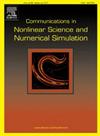具有立方非线性的薛定谔方程的能量稳定有限元法的无条件超收敛误差分析
IF 3.4
2区 数学
Q1 MATHEMATICS, APPLIED
Communications in Nonlinear Science and Numerical Simulation
Pub Date : 2024-10-08
DOI:10.1016/j.cnsns.2024.108383
引用次数: 0
摘要
本文利用能量稳定的有限元方法研究了三次薛定谔方程的无条件超收敛分析。本文提出了一种不同的方法,无需使用以往文献中要求的时间分割技术,即可首先获得 H1 规范下的无条件超收敛误差估计。分析的关键是利用数值解在能量规范中的先验有界性,并通过两种情况严格控制非线性项,即 τ≤h2 和 τ≥h2,其中 τ 表示时间尺寸,h 表示空间尺寸。随后,通过有效的插值后处理方法得出了 H1 规范下的全局超收敛误差估计值。最后,进行了一些数值实验来证实理论结论。本文章由计算机程序翻译,如有差异,请以英文原文为准。
Unconditionally superconvergence error analysis of an energy-stable finite element method for Schrödinger equation with cubic nonlinearity
In this paper, the unconditionally superconvergence analysis is studied for the cubic Schrödinger equation with an energy-stable finite element method. A different approach is proposed to obtain the unconditionally superclose error estimate in -norm firstly without using the time splitting technique required in the previous literature. The key to the analysis is to use a priori boundedness of the numerical solution in energy norm and control the nonlinear terms rigorously by two cases, i.e., and , where denotes the temporal size and is the spatial size. Subsequently, the global superconvergence error estimate in -norm is derived by an effective interpolation post-processing approach. Finally, some numerical experiments are carried out to confirm the theoretical findings.
求助全文
通过发布文献求助,成功后即可免费获取论文全文。
去求助
来源期刊

Communications in Nonlinear Science and Numerical Simulation
MATHEMATICS, APPLIED-MATHEMATICS, INTERDISCIPLINARY APPLICATIONS
CiteScore
6.80
自引率
7.70%
发文量
378
审稿时长
78 days
期刊介绍:
The journal publishes original research findings on experimental observation, mathematical modeling, theoretical analysis and numerical simulation, for more accurate description, better prediction or novel application, of nonlinear phenomena in science and engineering. It offers a venue for researchers to make rapid exchange of ideas and techniques in nonlinear science and complexity.
The submission of manuscripts with cross-disciplinary approaches in nonlinear science and complexity is particularly encouraged.
Topics of interest:
Nonlinear differential or delay equations, Lie group analysis and asymptotic methods, Discontinuous systems, Fractals, Fractional calculus and dynamics, Nonlinear effects in quantum mechanics, Nonlinear stochastic processes, Experimental nonlinear science, Time-series and signal analysis, Computational methods and simulations in nonlinear science and engineering, Control of dynamical systems, Synchronization, Lyapunov analysis, High-dimensional chaos and turbulence, Chaos in Hamiltonian systems, Integrable systems and solitons, Collective behavior in many-body systems, Biological physics and networks, Nonlinear mechanical systems, Complex systems and complexity.
No length limitation for contributions is set, but only concisely written manuscripts are published. Brief papers are published on the basis of Rapid Communications. Discussions of previously published papers are welcome.
 求助内容:
求助内容: 应助结果提醒方式:
应助结果提醒方式:


